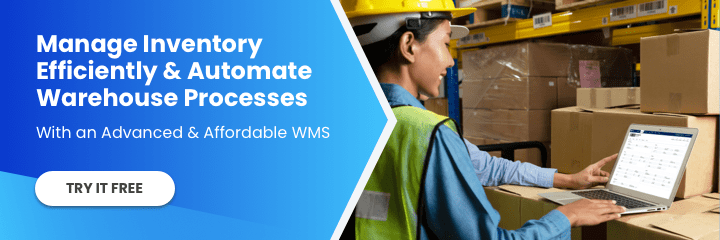In today’s fast-paced world, having the right warehouse management system offers various benefits that increase your business growth. A WMS can help in multiple ways, from optimizing your warehouse processes to providing visibility into your inventory levels.
 In this blog, we’ll cover nine of the most critical benefits of a warehouse management system and how it can help your business stay ahead of the competition.
In this blog, we’ll cover nine of the most critical benefits of a warehouse management system and how it can help your business stay ahead of the competition.
9 Most Critical Benefits of a Warehouse Management System
1. Optimize Primary Warehouse Operations
Selecting the right WMS for your business can help you seamlessly optimize the six fundamental warehouse processes. Here is how a warehouse management system benefits your operations:
a. Receiving
Tools like a warehouse management system benefit your warehouse receiving by allowing you to quickly scan inventory when received and verify that the right product is received in the right quantities, condition, weight, and dimensions simultaneously. This also automatically updates your inventory count based on what is received.
b. Put-Away
Another benefit of a warehouse management system is that it automatically assigns optimal spaces for each cargo, allowing for a streamlined put-away process and maximized space utilization.
c. Storage
Optimizing the storage process is another benefit of a warehouse management system. A WMS can help track the right storage KPIs, ensuring you’re fully utilizing the available space in your warehouse.
d. Picking
A WMS helps optimize the picking process by automatically generating picking lists based on orders and subtracting the picked cargo from the inventory count.
e. Packing
Another advantage of a WMS is that it optimizes the packing process by automatically assigning packing tasks after picking cargo. It also allows you to determine the type and amount of material required for packing because it has dimension & weight data, item type information, and more.
f. Shipping
A warehouse management system can help you optimize the shipping process by streamlining the dimensioning process, verifying that the right cargo is being shipped, and producing the required documentation.

2. Get Real-Time Inventory Visibility
A warehouse management system provides real-time inventory visibility and prevents you from making decisions based on outdated, inaccurate inventory information. Cloud-based WMS also allows you to see the latest inventory data from anywhere, regardless of whether or not you’re physically in the warehouse. This benefit of a WMS software enables you to track each item entering the warehouse and its movements while moving from one area to another. This allows you to minimize forgotten, lost, or misplaced inventory, which leads to more satisfied customers.
3. Manage Inventory Across Multiple Warehouses
Another benefit of a warehouse management system is multi-warehouse inventory management. A warehouse management system with this advanced feature allows you to manage multiple warehouses from a centralized application. This WMS advantage offers visibility across your inventory from numerous warehouses or any individual warehouse level. It enables you to save time coordinating between warehouses, allowing you to focus on your business objectives.
4. Reduce Operating Costs
A warehouse management system determines the most effective use of labor and space to minimize waste. This WMS benefit is achieved by assigning the right personnel to the right task and determining where to keep certain materials, products, and equipment to optimize the flow of your warehouse.
5. Automate Capturing Cargo Dimensions, Weight, & Images
Warehouses need to capture dimensions, weight, and images of hundreds or even thousands of pallets and parcels daily, and humans can’t match the accuracy and relentless pace of automation. Moreover, manually measuring and recording cargo are prone to human error, compromise safety, and take up long processing time, resulting in poor efficiency and low productivity.
A WMS automates the dimensioning process and accurately takes a parcel’s dimensions, weight, and images within a few seconds. This benefit of a WMS software saves you hours without reducing accuracy.
6. Automate Repetitive Tasks
Warehouse operations include various tedious, repetitive, and time-consuming tasks, leaving them vulnerable to inefficiencies and human error. These tasks can be simplified with the help of a workflow automation feature of a WMS. This feature allows you to automate repetitive manual tasks, such as sending automatic email notifications, generating picking lists and tasks, and more.
As a result, workers can spend more time on complex and higher-value work. Automation in the warehouse helps eliminate human error, improves worker safety and efficiency, and boosts overall productivity.
7. Increase Labor Productivity
A WMS is an excellent tool for increasing labor productivity. You can do so by configuring tasks beforehand according to workers’ skills, and the WMS will assign these tasks at the right time according to the configuration. This removes the need to manually create and assign tasks, eliminating downtime.
Another benefit of WMS software is that it can automate manual, tedious, and repetitive tasks within the warehouse, allowing your labor resources to do more productive tasks.

8. Achieve High Traceability
Traceability is another benefit of a WMS that allows warehouses to accurately track the movements of goods from the moment they enter the warehouse until they are finally shipped out. It lets you easily trace your goods in real-time in case of any misplacement, inaccuracy, or bad batch discovered. Moreover, it improves efficiency by eliminating manual inventory tracking and providing accurate and detailed inventory data.
9. Paperless Documentation
In today’s competitive business world, sticking with traditional paper documentation is a serious problem. Paper documentation is not only time-consuming and labor-intensive but also prone to errors, damage, and loss. It is difficult to keep track of paper documents and retrieve them when needed, leading to delays and inefficiencies in business operations. Moreover, paper documents require physical storage space and are difficult to audit due to poor searchability.
A WMS promotes paperless documentation by digitalizing most processes and allowing reports, bills of lading, packing slips, invoices, and other documents to be stored electronically. Reducing paperwork can help reduce costs, increase efficiency, minimize carbon footprint, improve visibility, etc.
Conclusion
The benefits of a warehouse management system are apparent at this point. A well-designed warehouse management system with the right features is one of the most effective methods for streamlining warehouse operations, optimizing inventory management, and increasing your business growth. It is essential in this day and age to find the right WMS for your business to stay competitive in the market.
To find an advanced and affordable WMS guaranteed to increase your warehouse efficiency, click here.
For more information about warehouse management systems or the latest warehouse technologies trends, you can follow us on LinkedIn, YouTube, Twitter, or Facebook. If you have other inquiries or suggestions, feel free to contact us here. We’ll be happy to hear from you.
- SEO Powered Content & PR Distribution. Get Amplified Today.
- EVM Finance. Unified Interface for Decentralized Finance. Access Here.
- Quantum Media Group. IR/PR Amplified. Access Here.
- PlatoAiStream. Web3 Data Intelligence. Knowledge Amplified. Access Here.
- Source: https://articles.cyzerg.com/most-critical-benefits-of-a-warehouse-management-system





